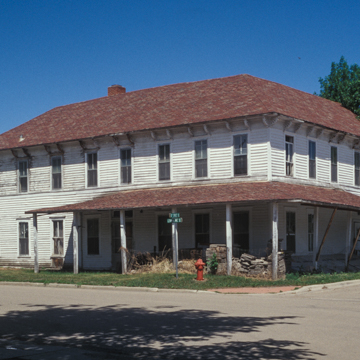You are here
Commercial Building (Andrews Hotel, Dakota House Hotel)
This straightforward two-story building shows a commercial version of Greek Revival influence. Its hipped and decked roof is lined with pairs of shell brackets within a frieze band tucked under the eaves above uniformly spaced two-over-two windows. Window hoods and sills are emphasized by a wider horizontal trim board below the second-story sills, and most of a shed-roofed, post-supported porch survives, wrapping the corner. In all, this unassuming former hotel is not without a rhythm and aesthetic balance. The building was commandeered as an influenza clinic and hospital in 1918 during the Spanish flu epidemic. It is currently unoccupied and waiting a new use.
Writing Credits
If SAH Archipedia has been useful to you, please consider supporting it.
SAH Archipedia tells the story of the United States through its buildings, landscapes, and cities. This freely available resource empowers the public with authoritative knowledge that deepens their understanding and appreciation of the built environment. But the Society of Architectural Historians, which created SAH Archipedia with University of Virginia Press, needs your support to maintain the high-caliber research, writing, photography, cartography, editing, design, and programming that make SAH Archipedia a trusted online resource available to all who value the history of place, heritage tourism, and learning.















